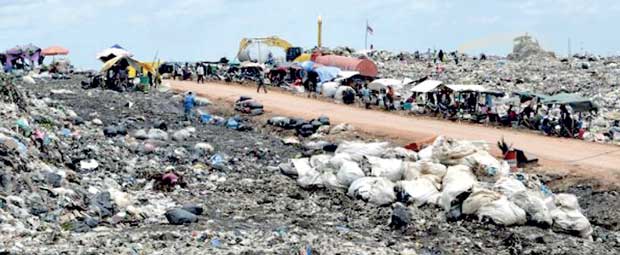29 Jun 2017 - {{hitsCtrl.values.hits}}

 Asia’s cities are the engines of incredible economic growth. For many countries, they generate over 80 percent of gross domestic product (GDP) and improve the lives of millions of people.
Asia’s cities are the engines of incredible economic growth. For many countries, they generate over 80 percent of gross domestic product (GDP) and improve the lives of millions of people.
But this prosperity comes with a price. Take for example the more than one million tonnes of solid waste that cities generate every day as they grow.
Without proper management, the deluge of solid waste causes severe pollution, helps diseases spread and generates greenhouse gas emissions. It can also exacerbate urban flooding, which can endanger lives and compromise livelihoods particularly for the poor and marginalized.
Despite these impacts, managing solid waste remains a low priority for most Asian cities, especially when compared with investment in other sectors such as transport, water and health services.
Waste management is an issue that is regularly ignored or, at best, given token consideration.
If we are to meet the target five of Sustainable Development Goal no. 12 (substantially reduce waste generation by 2030, ensure sustainable consumption and production patterns), urban solid waste management interventions can no longer be piecemeal or underfunded.
Over the next decade, along with energy and transport infrastructure, we need to invest more in integrated solid waste management processes and facilities. If we don’t, making developing Asia’s cities livable in the future will be nothing more than a pipe dream.
To help provide a way forward for city planners, the Asian Development Bank (ADB) is helping five Asian cities explore how they can better manage their solid waste. So far we noticed shortcomings that are consistent across cities of different sizes and locations. Here are five lessons learned that can be applied to other cities in the region.
1. Opt for technology within your budget
Insufficient budget is the main reason that the Asian cities don’t invest in improved solid waste management. However, cities often want to—or are convinced they must—invest in the best technology available, which they often can’t afford.
Cities should adopt the best available technology that is also the most economically achievable and effective within their budget.
In the Thai city of Mahasarakham, waste minimization is a key component of a solid waste management plan. Simple innovations such as chippers or balers help reduce the volume of waste entering landfills.
2. Improve waste collection, haulage efficiency
In Mandalay, Myanmar, improving waste collection efficiency involves replacing the manual loading of trash into trucks with more appropriate solutions—like skip bins—to provide greater haulage.
Communities in the Philippine city of Sorsogon practice simple composting through material recovery facilities. In all the pilot cities, although particularly in Buriram, Thailand, people are encouraged to reduce, reuse and recycle waste.
Buriram also separates organic, recyclable and hazardous waste from the residual waste and strongly encourages diverting as much waste as possible from going to landfills.
3. Fix landfill use
Changing landfill management can arguably make the greatest impact in cities, especially those with big landfills such as Payatas in Quezon City, Philippines.
We learned that in developing Asia, most landfills are inefficient not due to poor design but rather because they are poorly operated. To improve landfill practices, landfills should be designed to a standard that is environmentally sustainable and economically achievable. Adopt controlled landfills instead of fully engineered facilities, if these are not absolutely necessary.
Similarly, many of the landfills we studied were reported to be almost full and keeping them running requires significant investments. However, in all cases it was demonstrated that simple improved management practices and better planning could extend the landfill life cycle from the remaining two to three years to 10, 15 and even more than 20 years.
4. Introduce PPPs
Involving the private sector in integrated solid waste management can be pivotal to address Asia’s urban solid waste management problem. The private sector will not only provide badly needed finance, but also increase efficiency and deploy technology.
For some cities, experience with public-private partnerships (PPPs) is still at an early stage and many have entered agreements that are not clearly beneficial for them or their citizens.
Careful analysis and understanding of this arrangement using independent experts and honest brokers before a project is initiated will encourage cities to embrace PPPs.
At the ADB, we believe a PPP model that supports a cluster of cities—rather than a single city—can potentially trigger wider adoption of waste management practices; cities will feel compelled to commit to improving their own activities after seeing the success of other cities.
5. Implement long-term awareness-raising campaigns
Long-term and consistent social marketing campaigns, carried out across multiple generations, help sustain the message of proper disposal and can lead to lasting behavioural change. Quezon City has been very active in this front.
Mandalay showcases the benefits of waste management and recycling in school activities. When a student promises to teach their parents about how to properly throw out trash, information, education and communication (IEC) campaigns become a force multiplier.
Unfortunately, IEC campaigns needs to span many years and multiple budget and project cycles to be truly effective. It is critical that these activities are framed that way from the beginning, or they risk becoming wasted resources themselves.
The current approach to solid waste management in many small to mid-sized cities in Asia is insufficient. A more pragmatic approach, complemented with thorough planning and innovative financing, is the best way forward.
(Andrew McIntyre is Principal Social and Urban Development Specialist, East Asia Regional Department, the Asian Development Bank)
08 Jan 2025 8 minute ago
07 Jan 2025 7 hours ago
07 Jan 2025 7 hours ago
07 Jan 2025 8 hours ago
07 Jan 2025 07 Jan 2025